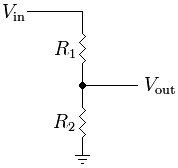1st pardon me for my non-standard way of explaining things, i'm no ee "engineuers" and i "aint no A?tium", and i think i hate to redraw, this typing alone is a tremendous effort i try to achieve. so i just post what i have done, if its not clear, please ask. i drew things in diptrace (non-standard my own library symbols) in "dog's breakfast sphagetty way" but i hope it will be self explanatory with its marking (i tried to be as standard as i can

) i also have tina-spice schematics, but i think those are from older version, i didnt update/redraw in latest revision, too tired with all the changes. i'll post when i see fits. and also pardon me for black style background, my eyes work better with that in diptrace.
first we start with the "well known" 3 opamps instrumentation amplifier, here (wiki image) for those who didnt know...

there's 2 opamps type, why 3? because its matched high impedance noninverting input, thats good, so thats the choosen one, right in the first place. the latest version will use gain 2X ins-amp (originally gain 10X)
and then, no opamp can take ±500V mains line direct, not even any high speed bjt/fet i'm aware of (only big type ones), even if there is, designing raw discreete transistors will complicate things astronomically for me, so i stayed with opamps as the simplest building block. so in order the opamp to eat the ±500V, it needs attenuator, resistors voltage divider is the only thing i can understand easily for now. again from wiki...

since we are dealing with high frequency input, some compensation using capacitors will be needed, something like this, in combo with the above...

(i'll use 1/100X divider in the latest revision, combo'ed with gain 2X in ins-amp, resulting in 1/50X to the scope input unterminated, and 1/100X if terminated, beauty!

)
thats it! simple isnt it? the rest is ofcourse... psu, and the supporting components (bypass caps, compensation networks, bnc or sma connectors and a bunch of coaxes and wires and cheapo smd hooks etc... and "very" good pcb layout to run it with, never excel with that yet) and of course, some tweaking with generator,scope and the circuit.
so all those basic things can be summarized in block diagram as below (diptrace)...
/?action=dlattach;attach=24799)
input=attenuator or voltage divider.
cmrr+differential = the mentioned 3 opamp ins-amp, i divided them into 2 parts
power = is power supply.
whats not shown is the output which is just a simple 50ohm terminated coax cable. and the image shown is for ver H above, but its been like that from the early stage, no change on this part/concept.
now lets take a look one by one at the block. we start first at psu, its nothing just a standard datasheet circuit using bipolar LM317/LM337 (jellybeans?) regulator. its the latest rev H. in earlier version, the regulator resides in the wallwart (or my bench psu), but now its integrated in the probe (due to some long story reason). here (diptrace ver H)...
/?action=dlattach;attach=24801)
the device will take unregulated bipolar supply from wallwart through LA_BATT tab there, regulated by the LM317/337 and feed the circuit (the other blocks) through the V+,gnd,V- connector there, ±12V supply to circuit, the opamps will be expected to output ±10V to the scope. simple! can be overclocked to ±15V supply to circuit if you wish for ±600V input, beauty!

and then the next block is the input rev G. here...
/?action=dlattach;attach=24803)
the important components are Ri+, Rd+ and series trimpot for matching and its negative counterparts just a mirror of them (divider is 1Mohm and 10Kohm, ie 1/100X), i leave the compensation part for you (Cci, Cod, Cadj etc), i provided more compensation network in case i need it.
in the latest input rev H, theres 3 network, LF compensation, MF and high freq (HF), probably i'm not going to need all, just in case. here's the half-completed rev H input (for 1X setting). 100Kohm input impedance (Rt+, Rt-), too low for ±5V input probing? yea, talking about the wrong (not so good) opamp buffer here (THS3092 1Mohm input). larger than 100Kohm terminator/pull down will output garbage nasty offset at the output. even with this 100Kohm, but thanks to the "drifty" null offset circuit (below)


/?action=dlattach;attach=24805)
next... cmrr+differential block. they form the 3 opamps ins-amp config mentioned above, with supporting circuit, compensation, null offset from zeners, trimpot and buffer to zero the output offset. this should be pretty simple. i leave the detailed explanantion to you to avoid "boringness", any questions just ask

ins-amp buffer is 2x opamp THS3092, and the differential opamp is THS3091. currently achieved BW is 20-50MHz (due to not so good input matching and compensation, reflections and other mystical things) so quite a waste for 100++MHz BW opamps. re-selection will be in order if required.
/?action=dlattach;attach=24807)
/?action=dlattach;attach=24809)
to the 4th post... the result...